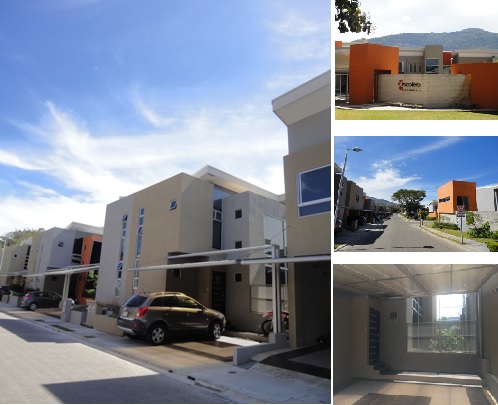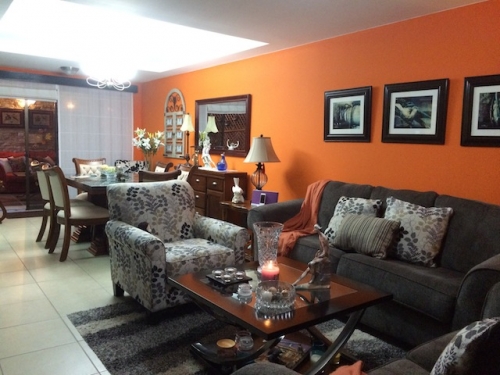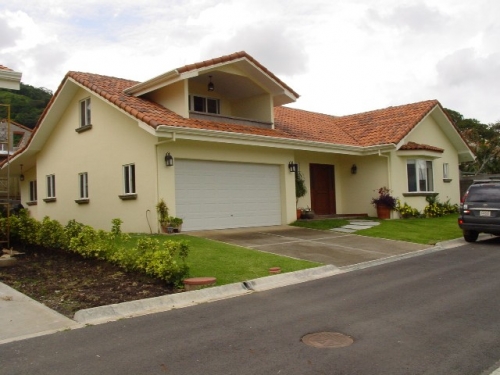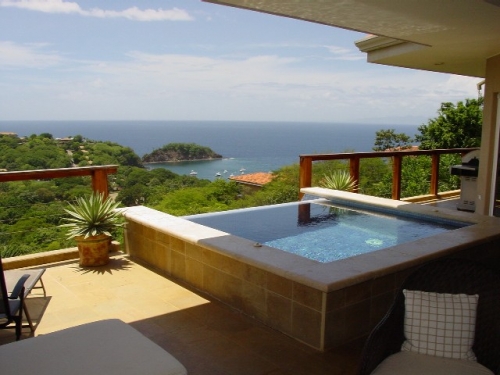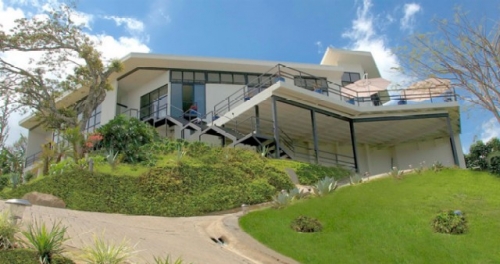Costa Rica Guide
Costa Rica Real Estate
List your property today!
Inclusion of real estate listings at Costa Rica Guide is
absolutely free of charge.
Featured Properties
Costa Rica Guide - Costa Rica Real Estate
Central Valley Region - Costa Rica Country Profile
Cosmopolitan San Jose sits at an altitude of 3,770 feet above sea level. This Central American city-with its nearly perfect climate, modern surroundings and warm, friendly residents-has lured many travelers to stay and call it home.
Daytime temperatures in San Jose average between 70 and 75 degrees Fahrenheit. During the rainy season, which lasts from May to October, showers fall primarily during the afternoon hours and produce refreshing breezes. The Central Valley in which San Jose finds itself contains the central nervous system of the country. Government, finance and economic sectors all headquarter in sleek San Jose. The city is home to nearly a third of Costa Rica’s population. The bustling streets attest to that in the early morning hours when everyone is heading to work. But don't be intimidated by the rush-head on out among them and take in the sights as you walk along. Before you begin your walking tour (taking it on foot is the best way to really experience the hustle and the beauty), be sure to visit the offices of ICT, The Costa Rican Tourist Board. Here you can pick up a comprehensive map of the city and of Costa Rica. Personnel here can point you in the right direction to several sights as well as provide you with bus routes and schedules for sights that are farther away.
San Jose offers many interesting attractions to entertain visitors. There are several museums; the National Theater, a centennial architectural jewel depicting the cultural level of this society, churches, parks, and an active nightlife featuring elegant gourmet restaurants and entertainment areas, including casinos, sports bars and more. Shopping is a must in the area, with shops and artisans displaying their work in selected areas of the city. If the thrill of the hunt for that perfect souvenir is just as exciting for you as bungee jumping, then Costa Rica won’t disappoint. And you certainly can work up a sweat walking from shop to shop if you like to get your exercise in a little more sedate way than climbing mountains. San Jose has a little bit of everything to buy. You’ll find the standard tourist fare like T-shirts and postcards. All manner of books have been written about this country, many of which make great souvenirs. Music stores have a wide selection of recorded music by local artists. And then there’s the distinctive art and handicrafts made by local, indigenous and international artisans.
More than a City Tour
San Jose is the perfect gateway to access not only the Central Valley but the entire country as well. Its cosmopolitan concept has turned the city into a mirror of the country’s culture, something clearly demonstrated in the excellent museum network that surrounds the city’s perimeter. Historical buildings and industrial complexes from the past have been transformed into houses of art, science and social achievements.
A former prison, a transformed airport terminal, a fortress housing the country’s history, an old liquor factory-constructions from the past that today, as museums, preserve the heritage of the Costa Rican people. Even though the builders of these structures never considered the possibility of them housing museums, the truth is that some of the most important museums in San Jose operate today within buildings that range from prisons to airports, adding more value to visitors interest.
The relatively small size of San Jose and the good location of its museums make it possible for visitors to tour the city’s museums on foot in one day, either alone or with a guide who will enlighten the circuit with proper comments and historical facts.
Old constructions with new means
The Costa Rican Art Museum located at Parque La Sabana, is a good start from the west side of the city. Several art collections depict the best of the fine arts created in Costa Rica throughout history, with the work of national masters in techniques such as water color, oil, and sculpture.
The excellently preserved building used to be the city’s international airport. It recreates an atmosphere resembling the 1950’s architectural style. The museum is open Tue-Sun 9:00 a.m., 5:00 p.m.
One of the capital’s real gems is the National Museum (Museo Nacional), housed in the 114-year-old Bellavista Fortress, a former army barracks that sports a few bullet holes in its towers. But not to worry. Costa Rica has no more army and the building’s central courtyard, overlooking the Plaza de la Democracia, is one of the most peaceful settings in the center of the crowded city.
With one of the country’s most active research facilities and educational programs, the National Museum is one of those "little bit of everything" places. It really shines when it comes to Costa Rica’s indigenous heritage and enviromental exhibits. (Calle 17, Ave. Central /2; open Tue-Sun 8:30 a.m.-4:30 p.m.)
The imposing castle-like building just north of downtown houses the Children’s Museum (Museo del Niño). Believe it or not, this used to be the city’s prison.(Ave. 9, Calle 4; open Tue-Fri 8 a.m., 3 p.m., Sat-Sun 10 a.m., 4 p.m.)
A sanctuary of images
The 11th floor of the National Insurance Institute (INS) houses the Jade Museum (Museo de Jade). Considered one of the world’s largest museums of its type, visitors should plan at least an hour or two in this impressive facility for there is a wealth of information in models and enormous wall plaques.
It contains not only jade but also a marvelous assortment of clay pots and statues, gold ornaments, stone statues, implements, ceremonial altars and even pieces made of bone and shell.
The Jade Museum is perhaps one of San Jose’s preferred tourist attractions. (Ave. 7, Calle 11, open Mon-Fri 8:30 a.m., 4:00 p.m.)
Gold under the Cultural Square
At another museum nearby, all that glitters is gold. The Gold Museum (Museo de Oro), below the Plaza de la Cultura, is part of a complex of museums operated by Costa Rica’s Central Bank.
The museum’s vaults showcase yet another collection of pre-Columbian art. Among these displays, 2,300 pieces of gold jewelry, armored plates, and objects of religious devotion can be admired and studied. (Calle 5, Ave. Central/2; open Tue-Sun 10 a.m., 4:30 p.m.)
Costa Rica’s venue for modern art is the Contemporary Art and Design Museum (Museo del Diseno y Arte Contempo-raneo). Facing Parque Nacional, it is housed in the large arts complex known as the National Cultural Center (Centro Nacional de Cultura) which was once part of the National Liquor Factory. Fittingly, the Ministry of Culture has its offices in this complex, too. (Ave. 3, Calle 15/17; open Tue-Sat 10 a.m.-5 p.m.)
All city museums charge an admission fee. Inquire at the entrance area for rates and discounts for children.
Into the Central Valley
Costa Rica’s Central Valley has a lot to offer. If handicrafts and souvenirs are at stake, then a trip to Sarchi is a must. Widely known for its woodcrafts, the Sarchi area is a blessing for those in search of a famous hand-painted ox- cart and many other wooden designs including beautiful artistically carved doors.
The good thing about Sarchi is that one can visit the shops and admire the artists at work. Painting or carving delicate pieces featuring tropical designs ranging from birds to colonial settings, they use a wonderfully varied color palette.
If nature is what visitors are after, then San Jose is a key stop while in the country’s Central Valley. From the city it is easy to join a one day tour to one of the two main volcanoes that overlook, from the distance, the country’s capital. Poas Volcano is located in the northwestern area of the Central Valley, while Irazu Volcano is located to the northeast. In fact, a tour to Sarchi, sitting on the slopes of Poas can also combine with a visit to this semi-dormant smoky giant. A one-day tour can perfectly combine both destinations.
The Poas Volcano National Park
Created in January 1971, Poas Volcano National Park receives the largest number of visitors of any park in the country. The spectacle of the main crater is very dramatic. Botos Lake, located near the main crater has a developed series of natural trails waiting to be discovered, leading visitors through the great natural diversity that pervades the area.
Poas is a semi-conical volcano with multiple calderas at the top. In the bottom of the main crater there is a sulfur-rich, acid lake. As it dries, sulfur emissions increase, producing acid rain. North of the active crater, the Von Frantzius cone is the oldest eruptive center at the top of the massif. To the southeast lies another collapsed cone, filled by rainwater to form Botos Lake.
Life zones represented in the park are Montane Rain Forest and Very Wet Low Montane Forest. Although larger animals are scarce, the avifauna is diverse and abundant. A total of 79 species of birds have been identified. Few mammals are likely to be seen, though weasels, rabbits, squirrels and coyotes are present, along with frogs, toads, salamanders, snakes and insects.
A few interesting facts about the Poas Volcano are:
- Maximun height: 2.708 meters above sea level
- Main crater diameter: 1.320 meters
- Main crater depth: 300 meters
- Laguna Botos diameter: 400 meters
- Average temperature: 12°C
- Average rainfall: 3.500 mm per year
Schedule:
- May-November, 8:00 a.m. to 3:30 p.m.
- December-April, 8:00 a.m. to 4:30 p.m.
Poas Volcano is located about 30 miles northwest of San Jose, which is about a two-hour ride through a beautiful and scenic panorama.
The Irazu Volcano National Park
Declared as a National Park in June 1955, the Irazu zone is an area of interest for scientific and tourist purposes. Irazu Volcano is technically classified as a stratovolcano, which means that it is formed from different layers of volcanic material, and has an irregular semi-conical shape. It is composed of five craters: The main crater, the Diego de la Haya crater, Playa Hermosa crater, the Laguna crater, and the Pyroclastic crater. Irazu is an active volcano with fumaroles that erupt with pyroclastic flows and ash, accompanied by relatively light tremors.
The origin of the name Irazu comes from an Indian village on the slopes of the volcano that was called "Iztaru", meaning "mountain of quakes and thunders". Over the years, this was modified to Irazu.
The first documented eruption of Irazu was registered in 1723 by Diego de la Haya Fernandez, the governor of Cartago at the time. From 1963 to 1965, Irazu Volcano began a period of intense activity, which devastated the surroundings of the crater and seriously affected the cities of San Jose and Cartago.
The temperature varies from -3°C to 17°C. April to December is the rainy season, with an average precipitation of 2,158 mm. It is the highest volcano in Costa Rica, with an elevation of 3,432 meters above the sea level. Visitors can easily observe three of the craters, including the main crater which is 1,050 meters in diameter and 300 meters deep, and has a sulfurous green lake at the bottom.
Diego de la Haya crater is 690 meters in diameter and 80 meters deep. Playa Hermosa crater is a large ashy beach that is now dormant.
Irazu Volcano National Park is located about 45 miles from San Jose and 18 miles from Cartago, the largest city located on the slopes of this giant. Agricultural and cattle ranches abound in the area.
The above information is courtesy of Costa Rica Institute of Tourism (ICT).

